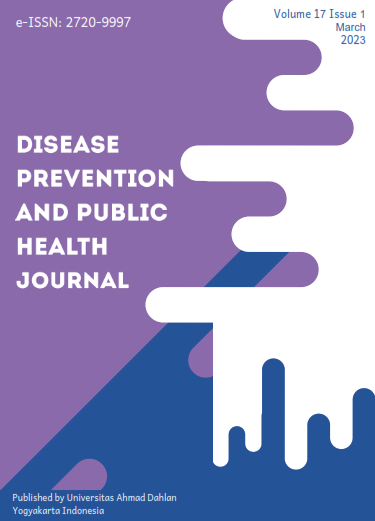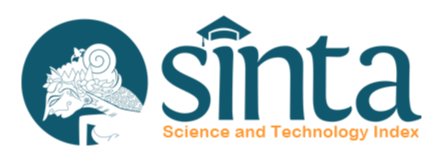Nutritional Intake of Children in Kebon Pala East Jakarta
DOI:
https://doi.org/10.12928/dpphj.v17i1.6512Keywords:
nutrition, body mass index, family healthAbstract
Background: A mother is the main nutrition provider of an Indonesian family. Their own health profiles and situations may affect their abilities to provide proper nutrition. In this research, we try to find mothers in Kebon Pala profile, and the nutrition taken by their children; Method: This quantitative descriptive study was conducted by using a self-administered questionnaire which has been responded to by 94 mothers in Kebon Pala. This research was conducted from October 2021-April 2022. Results: 61.54% child takes 3 times carb intake a day, but unlike the national nutritional guidelines, only 20% take anima-based protein 3 times a day, only 34.83% take plant-based protein 3 times a day, and only 33.33% take vegetable 3 times a day. This minimal variation of plate filling happened, even though 49.44% child never complained about the food available and 55.56% child never complained about vegetables/fruit on their plate. Conclusion: Children in Kebon Pala did not eat balanced nutrition meals, and most of them have eating difficulties (fussy eaters).
References
Budhyanti W, Lisnaini: Nutrition Status of Children in Kebon Pala, Jakarta. International Journal of Medical and Exercise Science, Sept 2022; 8(3):1323-1329. DOI: 0.36678/IJMAES.2022.V08I03.002
Samsudin, Nugraha B: Learning Method and Its Influence on Nutrition Study Results Throwing Ball. Journal of Education and Practice, 2015; 6(2). Doi: https://eric.ed.gov/?id=EJ1083839
Deki P: Factors Affecting Early Childhood Growth and Development: Golden 1000 Days. Journal of Advanced Practices in Nursing, 2015; 01(01), 1-7. Doi: https://doi.org/10.4172/2573-0347.1000101
Nafia ZI, Shodiq IZ, Handayani L: Nutritional Status of Children Under Five Years in the Work Area of Puskesmas Cipadung. Disease Prevention and Public Health Journal, 2021; 15(2):125-132. https://doi.org/10.12928/dpphj.v15i2.4748
Kobylińska M, Antosik K, Decyk A, Kurowska K. Malnutrition in Obesity: Is It Possible? Obes Facts, 2022; 15(1):19-25. doi: 10.1159/000519503
Taylor CM, Emmett PM: Picky Eating in Children: Causes and Consequences. Proc Nutr Soc, 2019; 78(2):161-169. doi: 10.1017/S0029665118002586
Chilman L, Kennedy-Behr A, Frakking T, Swanepoel L, Verdonck M. Picky Eating in Children: A Scoping Review to Examine its Intrinsic and Extrinsic Features and How They Relate to Identification. Int. J. Environ. Res. Public Health, 2021; 18(17): 9067; https://doi.org/10.3390/ijerph18179067
Lumeng JC, Kaciroti N, Retzloff L, Rosenblum K, Miller AL: Longitudinal Associations between Maternal Feeding and Overweight in Low-income Toddlers. Appetite, 2017; 113-23-29. https://doi.org/10.1016/j.appet.2017.02.016
N Chamidah et al Standard Growth Charts for Weight of Children in East Java Using Local Linear Estimator. J. Phys.: Conf. Ser, 2018; 1097 012092 doi: 10.1088/1742-6596/1097/1/012092
Kim JH, Yun S, Hwang SS, et al: The 2017 Korean National Growth Charts for Children and Adolescents: Development, Improvement, and Prospects. Korean J Pediatr. 2018; 61(5):135-149. doi:10.3345/kjp.2018.61.5.135
Berkes J, Raikes A, Bouguen A, Filmer D: Joint Roles of Parenting and Nutritional Status for Child Development: Evidence from Rural Cambodia. Developmental Science, 2019; 22(5) https://doi.org/10.1111/desc.12874
Jajat J, Suherman A: Indonesian Children and Adolescents’ Body Mass Index: WHO and Asia-Pacific Classification. Advances in Health Science Research 2019; 21. Doi: https://doi.org/10.2991/ahsr.k.200214.069
Eyong ME, Ikobah JM, Ntia H: Growth Parameters of Children in Calabar, A South-South Nigerian City: Are the CDC Growth Charts Useful in Clinical Practice in This Area? Niger J Paediatr 2020; 47(1):30-36 http://dx.doi.org/10.4314/njp.v47i1.6
Starc G, Popovic S, Dordic V, Ostojic S, Milanovic SM, Kujundzic E, Spiroski I, Duric S, Masanovic B, Sember V, Leskosek B: Differences in Body Height Between the Contemporary Western Balkan Children and the WHO Growth References Core Sample. Anthropological Notebooks 2019; 25(3): 55-67 doi: https://doi.org/10.5546/aap.2020.eng.117
Fernandez C, Mc Caffery H, Miller AL, Kaciroti N, Lumeng JC, Pesch MH: Trajectories of Picky Eating in Low Income US Children. Pediatrics, 2020; 145(6):e20192018. https://doi.org/10.1542/peds.2019-2018
Patel MD, Donovam SM, Lee SY: Considering Nature and Nurture in the Etiology and Prevention of Picky Eating: A Narrative Review. Nutrients 2020, 12(11): 3409; https://doi.org/10.3390/nu12113409
Taylor CM, Steer CD. Hays NP, Emmet PM. Growth and Body Composition in Children Who Are Picky Eaters: A Longitudinal View. European Journal of Clinical Nutrition, 2019; 73: 869-878. https://doi.org/10.1038/s41430-018-0250-7
Sandvik P, Ek A, Eli K, Somaraki M, Bottai M, Nowicka P: Picky Eating in An Obesity Intervention For Preschool-Aged Children—What Role Does It Play, and Does the Measurement Instrument Matter?. Int J Behav Nutr Phys Act, 2019; 16:76. https://doi.org/10.1186/s12966-019-0845-y
Jordan AA, Appugliese DP, Miller AL, Lumeng JC, Rosenblum KL, Pesch MH: Maternal Prompting Types And Child Vegetable Intake: Exploring The Moderating Role Of Picky Eating. Appetite, 2020; 146: 104518 https://doi.org/10.1016/j.appet.2019.104518
Agrawal S, Kim R, Gausman J, Sharma S, Sankar R, Joe W, Subramanian SV. (2019). Socio-Economic Patterning of Food Consumption and Dietary Diversity Among Indian Children: Evidence From NFHS-4 Eur J Clin Nutr 2019; 73:1361–1372. https://doi.org/10.1038/s41430-019-0406-0
Liberali R, Kupek E, de Assis AA: Dietary Patterns and Childhood Obesity Risk: A Systematic Review. Childhood Obesity 2020; 16(2):70-85. http://doi.org/10.1089/chi.2019.0059
Freitas-Vilela AA, Pearson RM, Emmet P, Heron J, Smith ADAC, Emond A, Hibbeln JR, Castro MBT, Kac. Maternal Dietary Patterns During Pregnancy and Intelligence Quotients in the Offspring at 8 years of Age: Findings from the ALSPAC Cohort. Maternal and Child Nutrition 2018; 14(1):e12431. https://doi.org/10.1111/mcn.12431
Hinnig PDF, Monteiro JS, De Assis MAA, Levy RB, Peres MA, Perazi FM, Porporanti AL, Canto GDL: Dietary Patterns of Children and Adolescents from High, Medium and Low Human Development Countries and Associated Socioeconomic Factors: A Systematic Review. Nutrients 2018; 10(4):436. https://doi.org/10.3390/nu10040436
Katherine R Arlinghaus, Kirstin Vollrath, Daphne C Hernandez, Shabnam R Momin, Teresia M O'Connor, Thomas G Power, Sheryl O Hughes, Authoritative Parent Feeding Style is Associated With Better Child Dietary Quality at Dinner Among Low-Income Minority Families, The American Journal of Clinical Nutrition, October 2018; 108(4): 730–736, https://doi.org/10.1093/ajcn/nqy142
Shinyoung J, Cowan AE, Tooze JA, Gahche JJ, Dwyer JT, Eicher-Miller HA, Bhadra A, Guenther PM, Potischman N, Dodd KW, Bailey RL: Dietary Supplement Use among U.S. Children by Family Income, Food Security Level, and Nutrition Assistance Program Participation Status in 2011–2014. Nutrients 2018; 10(9): 1212. https://doi.org/10.3390/nu10091212
Arcila-Agudelo AM, Svoboda CF, Torres-Fernandez T, Farran-Codina A. Determinants of Adherence to Healthy Eating Patterns in a Population of Children and Adolescents: Evidence on the Mediterranean Diet in the City of Mataro (Catalonia, Spain). Nutrients 2019; 11(4): 854. https://doi.org/10.3390/nu11040854
Luque V, Escribano J, Closa-Monasterolo R, Zaragoza-Jordana M, Ferré N, Grote V, Koletzko B, Totzauer M, Verduci E, ReDionigi A, Gruszfeld D, Socha P, Rousseaux D, Moretti M, Oddy W, Ambrosini GL, Unhealthy Dietary Patterns Established in Infancy Track to Mid-Childhood: The EU Childhood Obesity Project, The Journal of Nutrition, May 2018; 148(5): 752–759, https://doi.org/10.1093/jn/nxy025
Vepsäläinen, H., Nevalainen, J., Fogelholm, M. et al. Like parent, like child? Dietary Resemblance in Families. Int J Behav Nutr Phys Act 2018; 15:62 https://doi.org/10.1186/s12966-018-0693-1
Dalrymple KV, Flynn AC, Seed PT, Briley AL, O’Keeffe M, Godfrey KM, Poston L: Association Between Dietary Patterns, Eating Behaviours, and Body Composition and Adiposity in 3-Years-Old Children of Mothers with Obesity. Pediatric Obesity 2019; 15(5):e12608. https://doi.org/10.1111/ijpo.12608
Marniati, Putri ES, Sriwahyuni S, Khairunnas, Duana M. Knowledge Study, Income Level and Socio-Culture of the Nutritional Status of Toddler. J Nutr Sci. 2020; 1[2]:38–44. DOI: https://doi.org/10.35308/jns.v1i2.2770
Downloads
Published
Issue
Section
License
Copyright (c) 2023 Universitas Ahmad Dahlan

This work is licensed under a Creative Commons Attribution-ShareAlike 4.0 International License.
Authors transfer the copyright and grant the Disease Prevention and Public Health Journal right of first publication with the work simultaneously licensed under a Creative Commons Attribution License (CC BY-SA 4.0) that allows others to share (copy and redistribute the material in any medium or format) and adapt (remix, transform, and build upon the material) the work for any purpose, even commercially with an acknowledgement of the work's authorship and initial publication in Disease Prevention and Public Health Journal. Authors are able to enter into separate, additional contractual arrangements for the non-exclusive distribution of the journal's published version of the work (e.g., post it to an institutional repository or publish it in a book), with an acknowledgement of its initial publication in Disease Prevention and Public Health Journal. Authors are permitted and encouraged to post their work online (e.g., in institutional repositories or on their website) prior to and during the submission process, as it can lead to productive exchanges, as well as earlier and greater citation of published work (See The Effect of Open Access).

This work is licensed under a Creative Commons Attribution-ShareAlike 4.0 International License.







